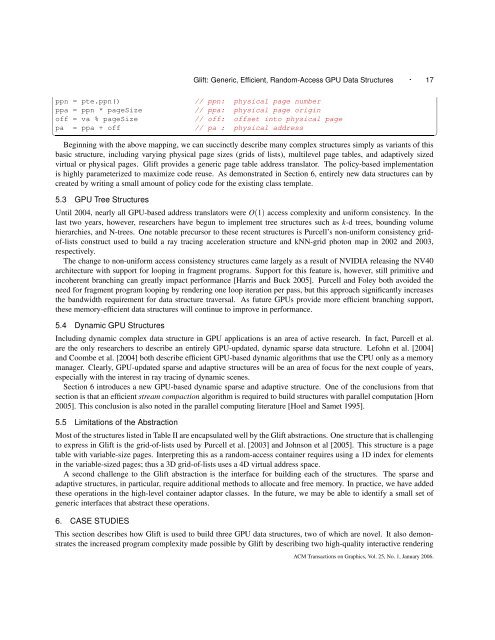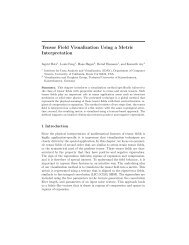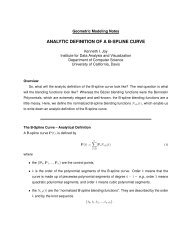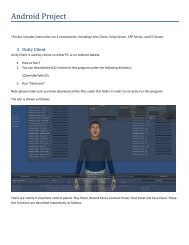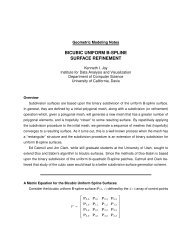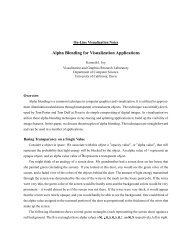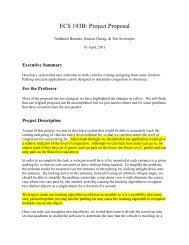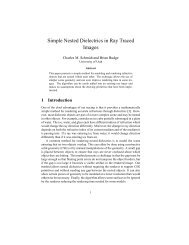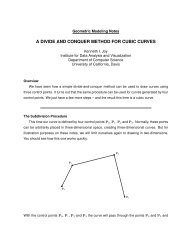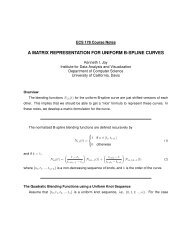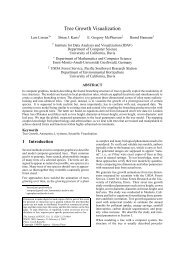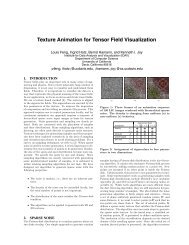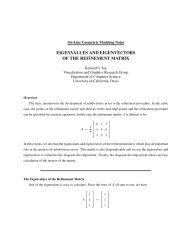Paper - IDAV: Institute for Data Analysis and Visualization
Paper - IDAV: Institute for Data Analysis and Visualization
Paper - IDAV: Institute for Data Analysis and Visualization
Create successful ePaper yourself
Turn your PDF publications into a flip-book with our unique Google optimized e-Paper software.
Glift: Generic, Efficient, R<strong>and</strong>om-Access GPU <strong>Data</strong> Structures · 17ppn = pte.ppn() // ppn: physical page numberppa = ppn * pageSize // ppa: physical page originoff = va % pageSize // off: offset into physical pagepa✝= ppa + off // pa : physical addressBeginning with the above mapping, we can succinctly describe many complex structures simply as variants of thisbasic structure, including varying physical page sizes (grids of lists), multilevel page tables, <strong>and</strong> adaptively sizedvirtual or physical pages. Glift provides a generic page table address translator. The policy-based implementationis highly parameterized to maximize code reuse. As demonstrated in Section 6, entirely new data structures can bycreated by writing a small amount of policy code <strong>for</strong> the existing class template.5.3 GPU Tree StructuresUntil 2004, nearly all GPU-based address translators were O(1) access complexity <strong>and</strong> uni<strong>for</strong>m consistency. In thelast two years, however, researchers have begun to implement tree structures such as k-d trees, bounding volumehierarchies, <strong>and</strong> N-trees. One notable precursor to these recent structures is Purcell’s non-uni<strong>for</strong>m consistency gridof-listsconstruct used to build a ray tracing acceleration structure <strong>and</strong> kNN-grid photon map in 2002 <strong>and</strong> 2003,respectively.The change to non-uni<strong>for</strong>m access consistency structures came largely as a result of NVIDIA releasing the NV40architecture with support <strong>for</strong> looping in fragment programs. Support <strong>for</strong> this feature is, however, still primitive <strong>and</strong>incoherent branching can greatly impact per<strong>for</strong>mance [Harris <strong>and</strong> Buck 2005]. Purcell <strong>and</strong> Foley both avoided theneed <strong>for</strong> fragment program looping by rendering one loop iteration per pass, but this approach significantly increasesthe b<strong>and</strong>width requirement <strong>for</strong> data structure traversal. As future GPUs provide more efficient branching support,these memory-efficient data structures will continue to improve in per<strong>for</strong>mance.5.4 Dynamic GPU StructuresIncluding dynamic complex data structure in GPU applications is an area of active research. In fact, Purcell et al.are the only researchers to describe an entirely GPU-updated, dynamic sparse data structure. Lefohn et al. [2004]<strong>and</strong> Coombe et al. [2004] both describe efficient GPU-based dynamic algorithms that use the CPU only as a memorymanager. Clearly, GPU-updated sparse <strong>and</strong> adaptive structures will be an area of focus <strong>for</strong> the next couple of years,especially with the interest in ray tracing of dynamic scenes.Section 6 introduces a new GPU-based dynamic sparse <strong>and</strong> adaptive structure. One of the conclusions from thatsection is that an efficient stream compaction algorithm is required to build structures with parallel computation [Horn2005]. This conclusion is also noted in the parallel computing literature [Hoel <strong>and</strong> Samet 1995].5.5 Limitations of the AbstractionMost of the structures listed in Table II are encapsulated well by the Glift abstractions. One structure that is challengingto express in Glift is the grid-of-lists used by Purcell et al. [2003] <strong>and</strong> Johnson et al [2005]. This structure is a pagetable with variable-size pages. Interpreting this as a r<strong>and</strong>om-access container requires using a 1D index <strong>for</strong> elementsin the variable-sized pages; thus a 3D grid-of-lists uses a 4D virtual address space.A second challenge to the Glift abstraction is the interface <strong>for</strong> building each of the structures. The sparse <strong>and</strong>adaptive structures, in particular, require additional methods to allocate <strong>and</strong> free memory. In practice, we have addedthese operations in the high-level container adaptor classes. In the future, we may be able to identify a small set ofgeneric interfaces that abstract these operations.6. CASE STUDIESThis section describes how Glift is used to build three GPU data structures, two of which are novel. It also demonstratesthe increased program complexity made possible by Glift by describing two high-quality interactive renderingACM Transactions on Graphics, Vol. 25, No. 1, January 2006.✆


